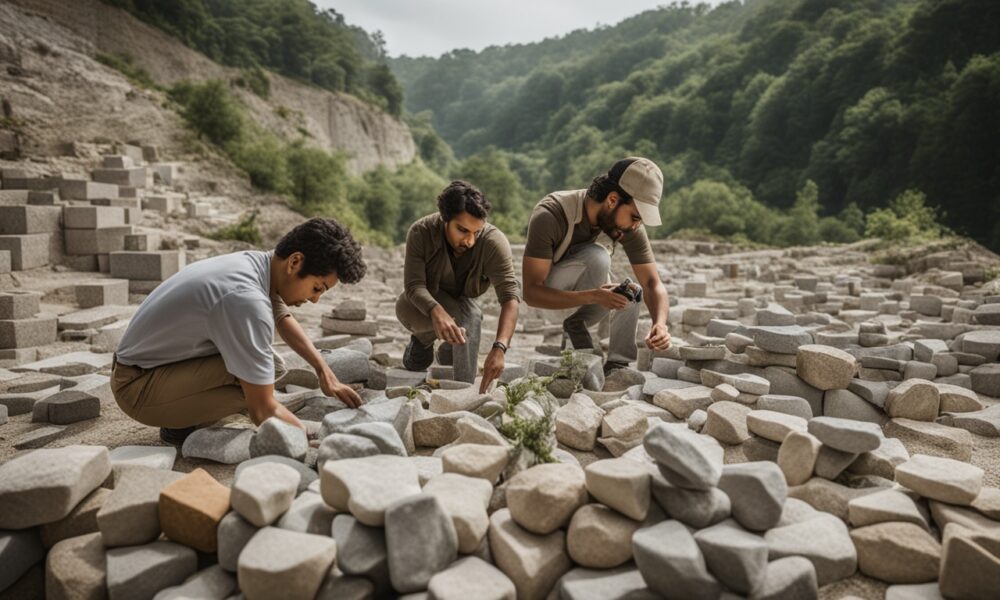Eco-Friendly Natural Stone Selection for Homes
Eco-friendly stone selection is changing the building world, bringing sustainable design to the spotlight. The Natural Stone Institute plays a big role in this change. For over 65 years, they’ve promoted environmental care in the industry. They help everyone pick stone that’s good for the planet. This is part of a bigger push for sustainability in building, led by programs like LEED and the NAHB’s National Green Building Standard.
Research shows how sustainability can be part of big projects. For example, The Crystal in London uses terrazzo, limestone, and recycled glass1. The Edge in Amsterdam chooses sustainable limestone1. These cases show how choosing the right stone can help the environment. They also guide people in picking eco-friendly stones for their homes.
Key Takeaways
- Sustainable home design benefits from eco-conscious stone selection.
- The Natural Ark Stone Institute has advocated for the industry’s environmental efforts for over 65 years.
- Programs like LEED and NAHB’s National Green Building Standard are promoting sustainable materials.
- High-profile projects like The Crystal and The Edge showcase the use of environmentally friendly stone choices.
- Natural stone options include marble, granite, limestone, and sandstone.
Understanding the Importance of Sustainable Natural Stone
Using natural stone sustainably is key to keeping our planet balanced. At the same time, we achieve stunning and practical designs. By choosing sustainable natural stone practices, we greatly lessen our ecological footprint in building projects.
Why Sustainability Matters
Sustainability is vital due to its positive effects on the environment and community welfare. The LEED V4 Certification highlights the need for clear information on the environmental impact and responsible product choices. This move encourages the use of green building materials2.
Opting for ethically sourced stone promotes eco-friendly habits and secures a brighter future for all. Stone’s longevity, lasting up to 100 years, boosts both durability and the value of buildings3.
Responsible Quarrying Practices
Ethical quarrying is crucial for natural stone sustainability. Polycor leads by example with NSC-373 certifications for its quarries, pushing for industry-wide sustainable standards2. These standards, from ANSI/NSC 373, assess natural resource use and labor conditions2.
They ensure workers are treated fairly and environmental harm is minimized. With many quarries close to U.S. and Canada construction sites, local stone sourcing cuts down on transport emissions3.
Energy-Efficient Production Methods
Adopting green production methods is essential. For example, Polycor’s water recycling slashes water use2. Technological advances have also made stone fabrication cheaper and more efficient. CNC machinery saves time and materials, aiding sustainability efforts3.
Natural stone production is inherently waste-light, generating little surplus material that can easily be recycled2. Such smart practices highlight the importance of choosing stone sources that value environmental and economic health.
How to Choose Sustainable Natural Stone for Your Home
Choosing sustainable natural stone for your home lowers your environmental impact. Consider important factors when choosing your stone. This will help you make an eco-friendlier choice.
Locally Sourced Stone
Choosing stone from local sources helps local economies and cuts emissions. In the UK, easy access to quality stone encourages eco-friendly choices. It reduces carbon emissions, making your choice more sustainable.
Recycled and Reclaimed Stone

Recycled and reclaimed stone lessens environmental harm. These stones add unique charm and history. Recycling old stones means less waste and more sustainability in design.
Durability and Longevity
Natural stone is known for lasting a long time. Granite is durable and easy to take care of, perfect for many home surfaces4. Marble adds timeless beauty but needs careful maintenance45.
Travertine and limestone are also durable and resist stains well4. Soapstone is great for kitchens and bathrooms because it’s heat-resistant4. Quartzite is tough against stains and wear5. It comes in various styles like Calacatta Quartzite5.
Choosing durable stones means less need for new resources. This quality makes natural stone a sustainable construction choice. It combines eco-friendliness with practical benefits.
Popular Eco-Friendly Stone Options for Your Home
When it’s time to pick eco-friendly stones for your place, several choices shine. They’re not just good for the planet but also pretty to look at. Each type of stone has its own perks. They fit different spots in your home depending on what you like and value.
Marble
Marble is all about looking good and staying cool. It comes in many styles and colors to make your space pop. It’s durable, so you don’t have to replace it often, which is great for the Earth6. Plus, having marble can even make your home worth more7.
Travertine
Travertine is both strong and beautiful, perfect for outdoors. It gives patios and paths a natural, timeless vibe. Since it can come from local sources, it’s better for the planet6. It doesn’t harm the environment much either6.
Granite

Granite is both affordable and tough, standing out among green choices. It resists wear and tear, making it great for busy areas6. It’s also well-suited for different climates7 and appeals to those looking to be kind to the environment6. Its long life means less need for replacements, aiding sustainability6.
| Stone Type | Key Benefits | Applications | Eco-Friendly Features |
|---|---|---|---|
| Marble | Cooling properties, elegance | Interiors | Durable, low waste production |
| Travertine | Versatility, longevity | Outdoor use | Locally sourced, minimal footprint |
| Granite | Cost-effective, resilient | High-traffic surfaces | Weather resistant, durable |
Benefits of Choosing Eco-Friendly Natural Stone
Choosing sustainable natural stone offers many good points for the environment and for practicality. It lasts a long time, which means less waste from needing to fix or replace it8. It also doesn’t need much care, making it a smarter choice than other materials8. This shows how efficient and good-looking it can be as a green option for many years.
Natural stone can be recycled and used again, which makes it even more sustainable8. It has been used for over fifty years, proving it’s a solid eco-friendly choice8. Its ability to handle heat and moisture also saves energy in homes8.
Top companies like Aravali Onyx get natural stones in a way that protects the environment8. They use new technology to cut down on waste, making the most of the resources they have8. They also save water and pick earth-friendly packaging, showing their care for the planet8.
The many uses of sustainable natural stone, like Onyx from Aravali Onyx, include floors, counters, walls, and garden highlights8. Talking with experts can help you pick the best stone for your eco-friendly home, considering how long it lasts, how much care it needs, and how it looks8.
To wrap it up, natural stone is a smart pick for those who care about the planet. Custom slabs are strong and offer lots of design choices, lasting through the years9. They can also save money on heating and cooling because of their insulation9. Plus, every piece of stone is unique, adding beauty to your home that never gets old9. For beauty, energy-saving, and a green home, natural stone is a top eco-friendly choice.
Conclusion
Choosing earth-friendly stone for homes is more than a choice. It’s a legacy for tomorrow’s world. By picking sustainable materials like natural stone, people make their homes both beautiful and responsible. Natural stone is not only durable but can also last centuries with the right care10.
It stands up well to daily use, resisting scratches and stains easily10. This makes it perfect for busy areas in a house.
Sustainable stones are taken from the earth in ways that don’t harm our planet. This shows the careful methods of quarrying10. Homeowners can shape their spaces thoughtfully, thanks to the industry’s strict practices. As a result, natural stone remains a key choice for green design, offering both style and sustainability.
Some stones also keep your spaces naturally cool, ideal for kitchen counters10. This elegant choice mirrors a deep respect for our environment. The merge of modern design with these materials shows a strong green commitment. To discover more about natural stone, take a look at the durability, aesthetics, and sustainability of natural stone in homes today.
FAQ
Why is sustainable natural stone important for home design?
What are responsible quarrying practices?
How does choosing locally sourced stone benefit the environment?
What are recycled and reclaimed stones?
What makes natural stone durable and long-lasting?
What are some popular eco-friendly stone options?
How does the production of eco-friendly natural stone minimize carbon footprints?
What are the benefits of using eco-friendly natural stone in construction?
Source Links
- Eco-Friendly Stones: Sustainable Solution For Stylish Living
- 8 Reasons Why Natural Stone is Sustainable – Polycor Inc.
- Top Five Reasons Why Natural Stone is a Sustainable Choice for Your Home – Use Natural Stone
- How to Choose the Perfect Natural Stone for Your Home: 7 Tips from Design Specialists – Carmel Stone Imports
- How to Choose Natural Stone That’s Right for Your Home – Jenny Komenda
- Natural Stones in Sustainable Design – Elements Room®
- Home Exterior Stone
- Natural Stone: Sustainable Design Choice for your Space
- 10 Reasons to Choose Custom Natural Stone Slabs for Your Home
- The Benefits of Using Natural Stone in Your Home: Durability, Aesthetics, and Sustainability



